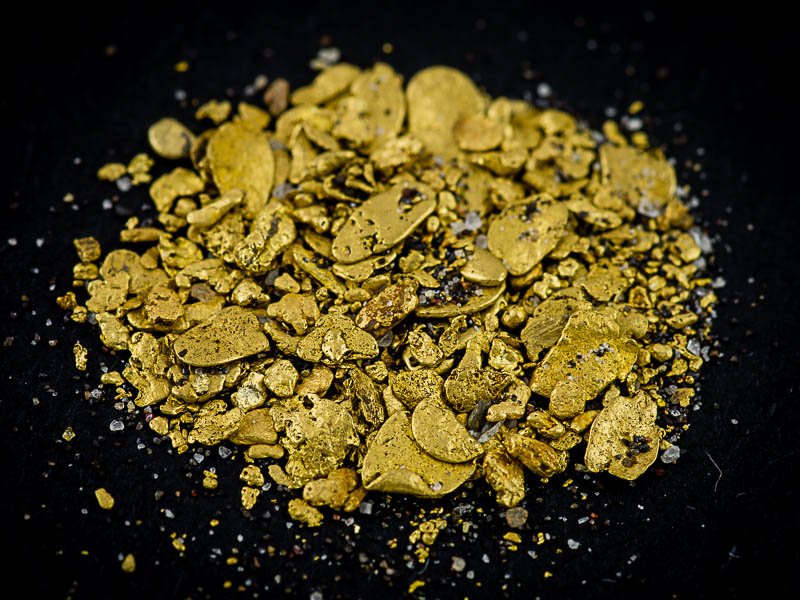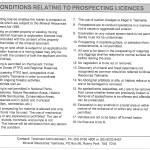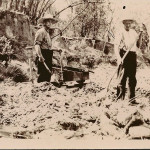A few weeks ago I wrote a post on alluvial gold, talking about where to go, and about gold panning.
Other alluvial gold prospecting tools
In this second part, I’ll go into other methods used traditionally (and nowadays) by prospectors to extract alluvial gold: the cradle (or rocker box) and the sluice, as well as a modern invention, the highbanker. Tasmanian prospecting regulations have been fairly confusing as to which you are and aren’t allowed to use. For example there are three different sets of prospecting regulations, two outdated versions on the Mineral Resources Tasmania (MRT) website here and here, and the ones printed on the physical licences issued by them (on the right, current as of July 2015). Why am I going into this? Well, it has a bearing on whether or not you can use a sluice in Tasmania.
As you can see on the scan, the current version of a physical Tasmanian prospecting licence (what you actually get given) states: “The use of motorized sluices, trommels, and pumps is not permitted“. The older versions say: “The use of sluices and trommels and motorised pumps is not permitted”, or “The use of sluices and trammels and motorised pumps is not permitted”, depending on which version you look at.
My personal interpretation of this is that, currently (Jul ’15), a river sluice is an allowed piece of equipment, since it’s not motorised, whereas a highbanker is arguably not allowed. Why do I say arguably? Because you can always argue that you are prospecting according to the rules, by using hand-tools only (digging up the dirt with a shovel), and what you’re doing with a sluice or a highbanker is processing the stuff you have already prospected. This is a fine line and I personally would not recommend testing it. There are also restrictions as to what you can do with water under the Water and Sewerage Industry Act 2008, which I’m not very familiar with, and they could potentially get you with those. Alright, enough rules stuff. What is it we’re talking about?
The cradle or rocker box
Other than the panning dish, the traditional rocker box is probably the only piece of equipment used for alluvial gold prospecting that is unambiguously not banned in Tasmania, as it uses only hand power.
When gold rush prospectors started to work the large discoveries in California, and then Australia, it became obvious that a panning dish wasn’t going to cut it, and many areas did not have enough water to run a sluice. Alluvial gold prospecting and mining is really about processing as much gold-containing dirt as fast as possible. If your dirt contains, for example, 500 mg of gold on average per ton, and you can pan two tons per day, you’ll end up, on average, with a gram of gold per day. On the same ground, if you use a cradle, which could process two to four times as much dirt as panning, you might end up with 2–4 grams of gold per day. Unlike a sluice, which needs a certain amount of water flowing through it in order to work (this volume is called a sluice-head), a cradle only needs a little water, and you can recycle it. You can see in the picture to the left that the guy standing by the rocker has a can on a pole to pour water onto the dirt. Cradles were normally worked by two people.
The basic layout has a classifier screen on top, to separate the rocks and break the clay clumps, on top an apron and a sloping board with riffles to catch the gold. The whole contraption can be rocked sideways, and the rocking movement helps both to mechanically break the clay, and also to drive the gold down so it catches in the riffles. You can see some diagrams here.
I’ve seen a few modern rocker boxes that use a pump to deliver water to the classifier, and they look much like a highbanker that rocks. I think the motor in these makes them sail a bit too close to the wind in Tassie at the moment, but some interesting versions, using manual bilge pumps, would seem to be allowable (this is my own personal opinion, don’t take it as gospel). You can see a good example here:
The sluice
The main tool used traditionally by alluvial prospectors and small-scale miners to separate heavy minerals from the wash was a sluice. Sluices come in many shapes and sizes, from small, light reconnaisance units used to prospect remote areas, to traditional ‘long toms’, like that on the right, which might be 10 or more meters long, and a permanent fixture in the ground.
If there was enough water flow in a creek, or a water race could be feasably built, the sluice could handle ten or more times the volume of dirt than a person could process by panning, producing a higher return. However, sluices were normally worked by a team of people (at least two), and this diluted the returns.
In essence a sluice is a channel for water than has obstructions or ‘riffles’ along the bottom. Washdirt is shovelled into the head of the sluice, and water naturally does the sorting and cleaning up, carrying the lighter material away. This is because alluvial gold is 19 times heavier than water, and about 6 times heavier than quartz sand and gravel, and quickly moves to the bottom of the sluice. Once it catches in a riffle, it’s very difficult to move it, compared to the lighter sand and gravel. The principle is the same that causes gold, tin, sapphires and other heavy minerals to concentrate in natural bedrock cracks.
Traditionally sluices were often made on-site from locally available timber (like the long tom above). Nowadays, they are most often of a back-pack portable size and made of aluminium, steel, or rotomolded plastic. For most efficient use, it’s better to classify (sieve) materials into a bucket before putting them into a sluice. This is for two reasons: 1) you need a lot less water flow to move lightweight, small material like sand; and 2) larger rocks tumbling down the sluice create turbulence that can knock smaller gold out of the riffles and cause it to end up flowing out of the sluice. If you’re working with strong water flow and putting unclassified wash through your sluice, it would pay to pan your tailings every now and then to make sure you’re not loosing gold.
Here’s a good example of one of the excellent Angus MacKirk sluices in action in Gippsland:
The highbanker
A highbanker is essentially a motorised sluice. It uses a pump, usually either a 12v sump pump, or a petrol pump, to pump water through a spray bar, and into a classifier on top of an elevated sluice. Material is shovelled directly into this classifier, and the high-pressure water sprays do most of the job of breaking up the wash and sending it into the sluice section. They have the disadvantage that they are much harder to carry around long distance in the bush than a small, lightweight sluice, and they’re comparatively very expensive (more than 10x the price, when you factor in pump, etc). They have the advantages that, if set up correctly, you can run them pretty much all day, the tailings don’t pile up at the base as fast, and they can be run off the stream into a tailings pond, so that the lighter tailings don’t pollute the stream.
Here’s a good video from Wal’n’Liz showing their own design of highbanker in use:
If you have time to watch other videos by Wal’n’Liz, there’s a ton of useful stuff in them.
Unfortunately, it looks like the prohibition to use any kind of motorised equipment for prospecting currently bans the use of highbankers in Tasmania. There are some arguments that have been used successfully interstate to allow the use of gear such as highbankers under similar regulations to ours. The main one is that, as I mentioned in the introduction for sluices and highbankers, a highbanker is not used for prospecting, but for processing material already prospected by hand-held tools (shovel), therefore complying with the rules of prospecting (taking a narrow view of the rules). However, there is absolutely no guarantee, if MRT miraculously got a budget for enforcement and you got raided, that the inspector would agree with your narrow view of the rules. Another possible argument is that, if you are not thinking of selling what you find, you could argue that you’re fossicking, instead of prospecting. The regulations for what you can do inside designated fossicking areas are strict, but I can find nothing in the relevant legislation (Mineral Resources Development Act 1995) or in official regulations that says that fossicking must only be carried out inside of a fossicking area… I think this is an important point, as MRT currently give contradictory advice, and I’ll probably write a whole post about it, along the lines of my Fossicking vs. Prospecting post.
Keep in mind that none of these arguments have been tested down here in Tasmania, and if you get prosecuted you’re liable for some pretty draconian fines (up to $77,000 if they charge you with mining without a lease), so please keep in mind I’m no legal expert, and the opinions I set out in this blog are strictly my own personal opinions and interpretations. There is no substitute for you reading up on the relevant legislation and the rules on prospecting, and making up your own mind.
Do you have any suggestions for what you’d like to see in future posts? If you like the content at Apple Isle Prospector, feel free to get in contact, or leave a comment.





Hi Miguel,
Great and informative sight.
It’s a shame the powers that be don’t exersise a bit of common sense, regulations on these matters should be very clear. I would like to prospect here in Tas, but it seems unclear can we use metal detectors, can we take our finds home, are we able to have access to good gold areas? $30 for a prospectors licence for a year what is this actually for? Other states have much better systems in place. Anyway keep up the good work maybe we will catch up some time.
Hi John,
Thanks for the comment. I agree the regulations should be clear and common sense. The position of the Director of Mines regarding ownership of minerals begs the question of what a Prospecting licence is actually good for. It seems we CAN use metal detectors. Still, it would be great to have this in the official regulations. Access issues are one of the areas that the newly formed PMAT will be chasing up. IMO we should also have a licence like Victoria or WA: cheap enough that people get one just in case they ever want to use it, and with clear rules on ownership of finds and so on.
Hi Russel here is there somewhere in Tasmania I can go camping with a sluse and just wast my day looking for gold
Hi Russel, there are a lot of areas on the West Coast you could do that in. Off the top of my head I reckon the Corinna area could be good. Try Middleton Creek or the creeks around Browns Plains. Long Plains is also good but Grange Resources, who currently own the Savage River mine, have it under exploration licence and don’t like visitors, particularly prospectors.
Other places might be Lisle (but stay out of the leases), or some of the creeks around Queenstown.